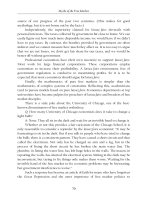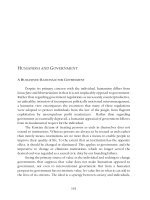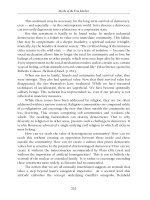age of inflation continued exposes criminal monetary policies of us federal reserve phần 1 pps
Bạn đang xem bản rút gọn của tài liệu. Xem và tải ngay bản đầy đủ của tài liệu tại đây (175.6 KB, 10 trang )
In 1978, when the last pages of Age of
Inflation were penned, the annual inflation rate
was on the rise. It peaked in 1980 at 13.58%,
before declining to a low in 1998 of 1.55%.
Today, inflation is on the rise again, but this
time, the U.S. has new problems as the world's
largest debtor. A new generation must cope with
the ageless problem called inflation. The
answers are different from those that worked
during the early 1980's. To understand today's
problems and solutions, see Age of Inflation
Continued.
CONTENTS
Inflation Without End 1
The Dollar Standard 8
Deep in Debt, Deep in Danger 17
Bubbles in Real Estate 26
No Conscience in Politics 33
In Search of a Lesser Evil 37
As Far as the Eye Can See 40
iii
Inflation Without End
In 1978, when the last pages of Age of Inflation were penned,
President Jimmy Carter was haggling and wrangling with
Congressional leaders about vexatious economic issues.
Consumer prices, which had risen 6.8 percent in 1977, were
climbing at an ever faster rate. In a televised address to the nation,
the President bravely addressed the problem: "It is time for all of
us to make a greater and more coordinated effort." He called for
workers to limit wage increases to 7 percent and asked companies
to hold price increases below those of 1976 and 1977. Yet the
dollar continued to decline. The President then announced a
number of federal actions including massive U.S. intervention in
foreign exchange markets to bolster the dollar. The fall of the
dollar nevertheless accelerated; its purchasing power shrank 7.62
percent in 1978, 11.22 percent in 1979, and 13.58 percent in 1980.
This was not the dawn of the age of inflation. Some
economists point to World War I, when nearly every country in the
world took recourse to nonconvertible paper money. For a few
years after the war, the standard was restored, although gold coins
were no longer in circulation in most countries. It was abolished
again during the great depression, by the United Kingdom in 1931,
the United States in 1933, and most European countries in 1936.
Soon thereafter, not a single country observed the gold standard.
1
Age of Inflation Continued
A few American economists hint at the inauguration of the Federal
Reserve System as the beginning of the age of inflation. The
System was established by law in 1913 and began to operate in
November 1914. Its primary functions ever since relate to the
maintenance of monetary and credit conditions favorable to
business activity in all fields. Its primary duties are lending its
funds, which it may create, and setting discount rates, which it is
free to manipulate. The dollar, which it has studiously managed
toward those ends, unfortunately has lost more than 91 percent of
its purchasing power in 91 years of Federal Reserve existence.
Other economists look upon the launching of President
Kennedy's "New Frontier" and President Johnson's "Great
Society" as the dawn of the age of inflation. President Kennedy
embarked upon massive spending programs of federal aid to
education, medical care for the aged, aid to depressed areas, and
an accelerated space program. President Johnson soon thereafter
launched his "War on Poverty" with a Job Corps, Opportunity
Head Start, Volunteers in the Service to America (VISTA),
Medicaid, and Medicare. The costs of these programs were made
to accelerate year after year—just like the costs of the Vietnam
War which President Johnson was waging. The Federal Reserve
System readily accommodated both federal courses of action with
generous issuances of money and credit. During the 1960s, it
made the U.S. dollar lose some 21 percent of its purchasing power.
The losses thereafter accelerated to 55 percent during the 1970s,
44 percent during the 1980s, 26 percent during the 1990s, and
some 15 percent so far in this decade. Relative to 1960
purchasing power, the U. S. dollar has become an anemic
currency, presently worth barely a dime. Surely, inflation is
gnawing at every U.S. dollar without reprieve or end in sight.
Some economists who define inflation in an old-fashioned way
point to the stock of money created or managed by the Federal
Reserve System.
2
Inflation Without End
U.S. Stock of Money
( in billions of dollars)
Federal Reserve
currency
Ml
F.R. currency
commercial bank
demand deposits
M3
F.R. currency
demand deposits
savings accounts
time deposits
1960
28.8
140.0
301.5
1970
46.0
206.2
618.3
1980
106.0
385.8
1826.4
1990
223.9
795.3
4091.7
2000
525.0
1121.6
6630.5
2005
718.7
1368.9
6680.5
Source: federalreserve.gov/releases
Academic economists who like to search for thoughts, notions,
and concepts that gave birth to the age of inflation point to
prominent thought leaders and authors who paved the way. The
pathfinder of them all undoubtedly was John Maynard Keynes,
whose ideas, based on large-scale government economic planning,
are best expressed in his work, The General Theory of
Employment, Interest, and Money (1936). Some economists who
faithfully followed in his footsteps were A. H. Hansen, R. F.
Harrod, P. A. Samuelson, A. P. Lerner, Joan Robinson, W.
Beveridge, to name but a few. Some writers such as O. Lange and
P.M. Sweezy even added a measure of Marxian thought in support
of their spending plans and programs. All these writers and many
more were the architects and framers of the policies which
legislators and regulators have been conducting faithfully and
fervently ever since.
Their preponderance in all matters of political and economic
thought has convinced us that the U.S. dollar will continue to
depreciate in the foreseeable future. Some financial analysts are
warning of much higher inflation rates to come, but many believe
3
Age of Inflation Continued
that the rates will remain relatively low despite soaring energy
prices. They are persuaded that high energy prices force many
consumers to cut back in other purchases which keeps the core rate
of dollar depreciation near two percent. In reality, consumers can
be expected to react in different ways to rising energy prices.
Many may be able to reduce their consumption of energy, others
who cannot cut back may curtail other consumption. Others yet
may simply bear the higher costs. Most people react directly to
price changes they anticipate. They first may cut back their
purchases when they expect goods prices to decline, which would
enable them to buy more in the future. They may hasten to
purchase when they expect future prices to soar. As the rate of
Federal Reserve monetary expansion varies frequently, we must
brace for reactive consumer cutbacks followed by rushes and
surges, in an unending sequel of stops and goes.
Mainstream economists and financial analysts usually cite
several more reasons why inflation will not soar and why the
dollar will maintain its position as the world's primary reserve
currency. They point to the Federal Reserve's boosts of its
discount rate to a level that is said to approach the market rate at
which member banks are discouraged from borrowing more
Federal Reserve funds. But we doubt that the present discount rate
of 4 1/4 percent is even close to the unimpeded market rate. Goods
prices presently are rising at 3 to 4 percent, which reduces the net
interest rate to 1/4 to 1 1/4 percent. Moreover, even if this were the
free market rate, it would not immediately affect the power of
commercial banks to continue their fiduciary expansion. After all,
they are loaded with mountains of excess reserves which the
Federal Reserve has so generously provided in the past. They can
continue to expand their credits at multiple rates. At a five percent
reserve requirement, a one-million dollar excess reserve allows a
bank to extend twenty million dollars in new credits. Of course,
it would always have to be careful not to expand its credits faster
than its actual reserves allow.
4
Inflation Without End
All over the globe, trade barriers have come down ever since
the disintegration of the Soviet empire and release of its satellites.
Many countries now are adjusting to world market conditions and
allowing foreign products and services to enter and compete.
Computers, software, and cell phones now are boosting
productivity in remote places, which are advancing from a horse-
and-buggy age to a computer age. Free trade and modern
technology are raising labor productivity and increasing world
competition, which is keeping a lid on world market prices. It
especially thwarts and frustrates unionized industries which
depend on legal protection and immunities. All such changes have
persuaded mainstream economists and analysts that this "global
war on inflation" has succeeded in eliminating the "inflationary
psychology" of companies around the world. Producers
everywhere, they are convinced, have learned to boost efficiency
and productivity rather than to simply raise prices.
We readily agree with such observations, but disagree with the
conclusions. Removal of many trade barriers since the
disintegration of the Soviet empire has increased economic
productivity and improved living conditions in many parts of the
world. Consumer goods from China, India, and many other poor
countries are competing effectively with U.S made products and
restraining most prices, but they do not weaken or even repudiate
the inflation ideology; in fact, alleviation of inflation effects may
encourage and reinforce inflation proper. It may induce the U.S.
government to continue to incur huge budget deficits, increase its
debt by the trillions, and prompt the Federal Reserve to facilitate
it all.
The U.S. dollar continues to function as the world's best-
known medium of exchange. Yet, we are rather fearful that
foreign central banks, which are holding large piles of U.S.
dollars, may some day dump some dollars to avoid ever larger
losses. We do not know the foreign creditors who will lead the
way and do not know when and why in particular they will unload
5
Age of Inflation Continued
their dollars. We cannot tell what the future will bring, but we do
know that the present monetary order is inept and anomalous and,
therefore, cannot last. It is bound to change, either gradually or
abruptly, either tomorrow, next year, or a decade from now.
The future may be uncertain, but several potential scenarios
come to mind. The optimists in our midst, living for something
better to come, are hopeful that the federal government may soon
learn to live within its means, that it will balance its budget and
begin to reduce its $8 trillion debt. But such optimism is rather
unrealistic; public opinion soon would take a stand against
spending reductions, many of which would be entitlement
reductions. No matter who resides in the White House or what
political party controls the Congress, most entitlements are beyond
the reach of review and, therefore, will continue regardless of
revenue and debt. In public life, instead of frugality and economy,
spending and dealing tend to hold sway.
Some optimists are confident that the Federal Reserve System
may check its expansion of currency and credit, which soon would
force member banks to cease and desist from their distention. But
such happy expectation is even more unrealistic and fanciful than
the hope of a balanced government budget. Federal Reserve
inactivity surely would allow the American economy to readjust
to actual market conditions; interest rates would rise until the
demand for funds and their supply would be equal, leading to a
readjustment recession with slumping production and rising
unemployment. As the federal government is unlikely to reduce
its spending during a recession, huge federal deficits would cause
interest rates to soar to double-digit levels and further depress
economic activity. Once again, the Federal Reserve would have
to come to the rescue by slashing interest rates and expanding the
stock of money. All along, public opinion would smile upon
benefit spending, condone budget deficits, and acclaim the Federal
Reserve for its valiant fight against recession and unemployment.
Some economists envision continuation of present monetary
6
Inflation Without End
policies with the U.S. dollar depreciating at a rate of two to four
percent. The Federal Reserve, we are told, is giving the country a
measure of stability and pointing the way to economic growth and
prosperity throughout the world. But these partisans blithely
overlook the huge federal government deficits, as well as the
massive trade deficits which render the American economy rather
vulnerable. American savings are at a record low and current-
account deficits are at a record high, which have ignited a global
housing boom, the biggest financial bubble in history. A world
economy so maladjusted is dangerously vulnerable to painful
readjustment.
The economic situation presently looks ominously like the
1970s, when inflation soared at double-digit rates. Surely, the
present bubble will burst, as all such bubbles did inexorably in the
past, but what will it do to the economy? With price inflation
edging up already, will the Fed slash its interest rates, as it did in
2001-2002, and thereby accelerate the dollar depreciation? And
how will the federal government react? With present budget
deficits at record highs, will it double the highs and reach six
hundred or even seven hundred billion dollars a year? We had
better prepare for one or the other, soaring inflation or a nasty
slump.
The worst conceivable scenario would be a combination of
present monetary and fiscal policies together with growth of
American protectionism. The federal government may regulate
imports and exports with the purpose of shielding domestic
industries from foreign competition. It may exclude certain
imports entirely, establish import quotas, or impose special duties
on imports, thereby increasing the price of the imported article.
Such measures undoubtedly would be popular with many domestic
industries but highly contentious in creditor countries. For a
debtor to strike at his creditors always is ill-advised and unwise;
it could spell the end of the world dollar standard. Indeed, a
mountain of debt casts a shadow on the brightest place.
7









